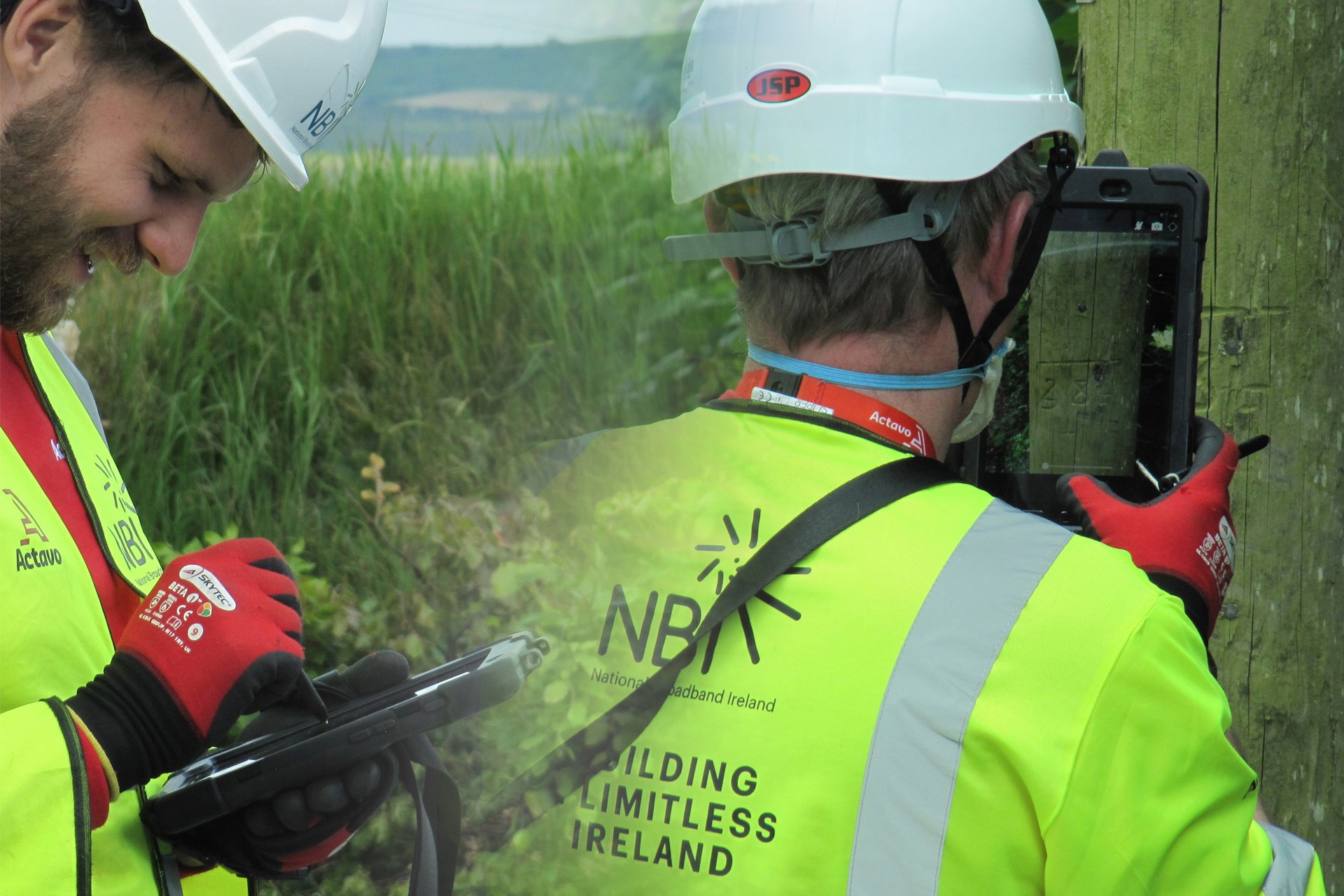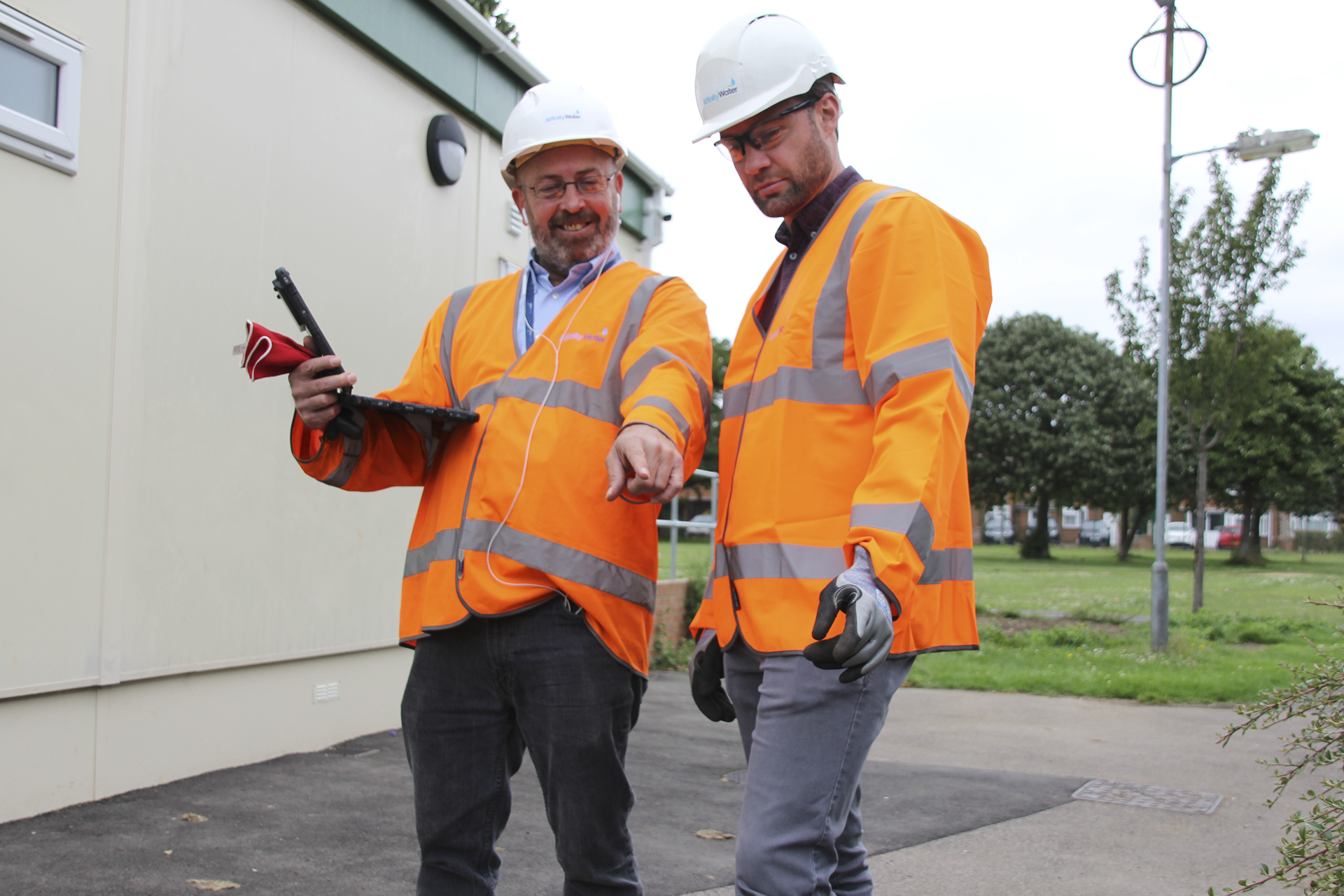Blog Archives
Post navigation

Homes England
Through our use of ArcGIS Experience Builder we are improving awareness of the availability of development land and helping the Government to achieve its target of 300,000 new homes per year.
Homes England is supporting the delivery of much needed homes in England with a trailblazing web app built using Esri’s new ArcGIS Experience Builder. Called Land Hub, the solution provides instant access to detailed information about the development plots that Homes England wants to sell, enabling housing developers to make faster, well informed investment decisions and accelerate the supply of new homes.
ArcGIS Experience Builder provides all the flexibility of an ArcGIS StoryMap, with additional search and querying capabilities
Usage of Homes England’s Land Hub app increased by 365% after it was redeveloped using ArcGIS Experience Builder
Land Hub has led to a reduction in email enquiries of up to 65%, improving the efficiency of Homes England’s customer services
The Challenge
Homes England has a vital role to play in helping the UK Government to achieve the ambitious target of 300,000 new homes per year, by the mid-2020s. As part of its mission to accelerate housing supply and create a more resilient, diverse housing market, the organisation facilitates the sale of publicly owned land, supporting the delivery of new homes and generating returns for the public purse. It used to produce a list, twice a year, of development plots that were for sale, but this basic document didn’t provide the level of information that developers needed to make informed decisions about what could be multi-million pound investments.
“Land Hub accelerates the supply of new homes by making information about development sites more accessible and transparent, and enabling house builders to make faster, well informed plans for new housing developments.”
Fiona Clowes, Head of Geospatial Environment, Homes England
The Solution
Using Esri’s ArcGIS, Homes England developed an online, interactive solution called Land Hub that makes information about potential development sites very easy for developers to find and explore. Initially, Land Hub was published in an ArcGIS StoryMap template. Then, twelve months later, Homes England redeveloped the solution using ArcGIS Experience Builder, becoming one of the first organisations in the world to take advantage of this versatile new app creation tool.
“We really liked the StoryMap approach as it gave us the ability to customise our site information and incorporate our own corporate style,” explains Fiona Clowes, Head of Geospatial Environment at Homes England. “However, when we found out about the new ArcGIS Experience Builder we were really excited about its potential and keen to put it to use. It offers all the components of a StoryMap that we like, but also gives us the ability to include more querying and searching capabilities.”
Available for anyone to use, on desktops and mobile devices, the latest version of Land Hub allows people to see all development sites on an interactive map and search for sites by local authority area or status (such as being marketed or in the pipeline). Once they click on a specific parcel of land, users can then view relevant information, such as the locations of flood alert areas and local authority green belts, local transport hubs and drone footage, all of which helps them to make an informed decision about whether or not to bid for the land.
Developers can also download data from Land Hub directly into their own GIS systems, so that they can analyse it in conjunction with their own data. Whereas Homes England’s original property list was only updated biannually, data in the Land Hub is currently updated quarterly, and Homes England plans to introduce monthly updates in the near future.
“Over the last twelve months, average usage of Land Hub has increased by 365% from 107 to 392 views a week, which demonstrates the value it adds for developers.”
Jimmy Overill, Development Manager, Homes England
Benefits
Rapid insight into development opportunities
The ArcGIS-based Land Hub solution gives developers faster and deeper insight into development opportunities across England, helping them to build more homes, more quickly. As Clowes says, “Land Hub accelerates the supply of new homes by making information about development sites more accessible and transparent, and enabling house builders to make faster, well informed plans for new housing developments.”
Cost and time savings for developers
The quality of the data that is available via Land Hub often removes the need for site visits and additional surveys, enabling developers to save time and money. For example, whereas an aerial image of a site might just show a large tree canopy, the drone imagery available via Land Hub allows users to peer beneath the branches and see the whole site, from multiple angles, without obstructions. Jimmy Overill, Development Manager at Homes England, says: “Over the last twelve months, average usage of Land Hub has increased by 365% from 107 to 392 views a week, which demonstrates the value it adds for developers.”
More efficient customer services
Using Land Hub, Homes England can now channel enquiries from developers to the right members of staff, depending on the plot of land they are interested in, and respond to them more quickly. In the past, the organisation used to receive over 100 emails each week, often asking the same questions, and it could take 2-4 weeks to respond. Now the organisation receives just 35-40 enquiries a week, because the answers to questions are already on Land Hub, and it can research and respond to more complex enquiries in just 4-5 days.
Confident bids for development sites
By making information about sites available much earlier, Land Hub enables housing developers to bid for sites with greater confidence. The platform allows Homes England to advertise sites that it is bringing to market up to nine months in advance of inviting tenders, which gives housing developers early sight of plots they may want to secure. Developers consequently have more time to thoroughly investigate sites and get all the information they require, such as Homes England’s requirements to use Modern Methods of Construction or to build the site out at pace.
An effective way to showcase success
In addition to advertising available land, Homes England also uses Land Hub to showcase the diverse range of sites that it has been able to make available, over time, which is suitable for developers of different sizes and different types of housing. “It is not just a marketing tool; it’s also a story board for how we’re working to diversify the market,” Overill says.

Thames Estuary Partnership
ArcGIS enables us to clearly demonstrate the damaging impact of barriers on migrating fish in the Thames and share data effectively with the stakeholders who can work with us to improve the Thames ecosystem.
Thames Estuary Partnership wants to create a more sustainable future for the 125 fish species that live in the River Thames. The not-for-profit organisation is using ArcGIS to encourage stakeholders to improve the quality of riverside habitats and reopen fish migratory routes that have been blocked for decades.
An interactive web app allows users to explore data on fish migratory routes, river barriers and habitats along the Thames and its tributaries
An engaging Story Map provides people with an interactive tour of the Thames, incorporating maps, images, video and information
Esri training resources and free online courses enabled Thames Estuary Partnership to optimise its use of ArcGIS with no external support
The Challenge
Flowing through the most densely populated city in Europe, the Thames is one of the world’s most famous rivers. Yet few people realise that this iconic and historic waterway is home to more than 125 species of fish, as well as marine mammals and migrating birds.
Thames Estuary Partnership was formed to provide a forum for stakeholders working in and around the Thames and engage with them to improve the natural environment of the estuary. To communicate the results of one of its in-house projects, the organisation needed a better way to share data about the river ecosystem and raise awareness of the importance of reopening fish migratory routes.
“Using our ArcGIS Story Map, everyone can tour the Thames in their own way, visiting just the locations they are interested in, or travelling all along the river from Teddington to the North Sea.”
Wanda Bodnar, Project Officer, Thames Estuary Partnership
The Solution
Thames Estuary Partnership evaluated a number of potential solutions before selecting Esri’s ArcGIS platform. “Usability and interactivity were the two critical requirements,” explains Wanda Bodnar, the organisation’s Fish Migration Roadmap Project Officer. “We discovered that ArcGIS makes it very easy for people to learn more about our projects.”
The organisation used ArcGIS Desktop to create an interactive ‘roadmap’ of the Greater Thames Estuary, combining data on fish migrations, habitat quality, artificial river barriers, flood areas and riverside developments. It then created a website using ArcGIS Hub to display the web map and made it publicly available online. Now anyone can explore the Greater Thames Estuary Fish Migration Roadmap to see the sections and tributaries of the Thames that are accessible to migrating fish, or blocked by artificial barriers, and access the quality of the river habitat in different locations.
Thames Estuary Partnership also used Esri’s Story Map template to create an interactive tour of the Thames called The Tidal Thames, to replace its annual boat trip which was cancelled due to the COVID-19 pandemic. The Story Map provides a highly informative, interactive and engaging description of different parts of the Thames. People can simply click on a point along the river course to go directly to a particular location and see images, play video clips and read interesting facts. “People are not overwhelmed with information,” Bodnar says. “Using our ArcGIS Story Map, everyone can tour the Thames in their own way, visiting just the locations they are interested in, or travelling all along the river from Teddington to the North Sea.”
Bodnar led on the development of the Fish Migration Roadmap and Tidal Thames Tour Story Map herself, with no professional support, after taking advantage of the wide range of free training resources and Massive Open Online Courses (MOOCs) offered by Esri. “The online training gave me ideas and helped me to make the most of ArcGIS,” she says. “It’s a brilliant self-supporting system that makes even the most complex projects manageable.”
“Now stakeholders can prioritise the removal of barriers that restrict access to upstream areas where the habitats are good.”
Wanda Bodnar, Project Officer, Thames Estuary Partnership
Benefits
Raised awareness of the impact of barriers
The Fish Migration Roadmap has enabled Thames Estuary Partnership to clearly illustrate how artificial barriers, such as locks, sluice gates and weirs, are preventing key fish species from reaching high quality habitats and spawning grounds. People can, for example, see the obstructions faced by the European Eel, a critically endangered species that travels across the Atlantic Ocean to mature from glass eels into silver eels in the Thames. “We have seen from social media that our message is being heard,” Bodnar says. “People retweet our Roadmap and comment on how they didn’t know before that there were so many barriers to fish migration in the Thames. We are also receiving expressions of interests from other NGOs interested in getting involved and working together.”
Intelligence gathered to inform investment decisions
Thames Estuary Partnership is now collaborating with stakeholders and using the Fish Migration Roadmap to demonstrate which barriers should be removed or adapted first. It is now possible to make key investment decisions based on a clear understanding of where high quality habitats can be opened up, by the adaptation of specific barriers. “Barriers used to be removed or adapted in an opportunistic way,” explains Bodnar. “Now stakeholders can prioritise the removal of barriers that restrict access to upstream areas where the habitats are good.”
Clear data amassed to encourage more sustainable riverside developments
Through its Fish Migration Roadmap, Thames Estuary Partnership can now make easily-understood, authoritative information instantly available to all local authorities, landowners and riverside developers working in the Thames region. All these stakeholders can use the roadmap to help them make better-informed decisions about how to best develop and manage the river banks for the benefit of wildlife.
Improved knowledge of the Thames
Viewed over 1,000 times in the first three months alone, the Tidal Thames Story Map enables everyone to get a deeper appreciation of the Thames, regardless of where they live. During the COVID-19 pandemic, when travel is highly restricted, the online Story Map gives people from as far away as Japan and the USA the opportunity to learn about the river Thames. “Most visitors to London just look at the Thames as it flows under Tower Bridge,” Bodnar says. “The Story Map shows people the foreshore, tells them about the wildlife living in the river and helps them understand the importance of reed beds further along the river edge. It offers near limitless potential as an educational tool.”

Actavo
ArcGIS is the pivotal technology enabling us to design a high-speed fibre broadband network that will help to deliver connectivity to 1.1 million people in rural Ireland.
Actavo is a primary contractor for the largest and most significant telecommunications initiative ever undertaken by the Irish government. The organisation is using ArcGIS to help fulfil the requirements of its contract as efficiently as possible and design a state-of-the-art, high-speed fibre broadband network which will help transform the lives and livelihoods of 1.1 million people in rural Ireland.
25 surveyors use Collector and Survey123 for ArcGIS in the field to survey 800 poles and 40km of cable a day
Designers use automated functionality in ArcGIS Pro to accelerate the design of the broadband network
Managers use Esri dashboards to manage the project and monitor the progress of surveyors working nationwide
The Challenge
The National Broadband Ireland project aims to bridge the digital divide between cities and rural areas in Ireland. It will deliver high speed internet connectivity to 537,000 buildings, providing 1.1 million people with better opportunities to learn, work and engage with others. However, before 146,000 km of new fibre cable can be laid, Actavo, one of the primary contractors appointed to the National Broadband Plan project, needs to undertake surveys across the country. It then needs to design the new broadband network, taking into account the requirement to reuse as much of the existing telecommunications infrastructure as possible to ensure efficiencies in cost and build time.
ArcGIS Pro reduces the need for a high number of design resources to deliver such a huge project, creating significant annual cost savings.
Lindsay Rountree – Project Lead, Actavo
The Solution
The organisation engaged consultants from Esri Ireland to help it develop a suite of GIS solutions specifically for the National Broadband Ireland project using Esri’s ArcGIS platform. Using a workshop approach, the Actavo team and Esri Ireland consultants brainstormed concepts for solutions, which the Esri Ireland consultants then developed, tested and fine-tuned until they precisely met the needs of the business. “Esri Ireland was very quick to turn ideas into solutions,” recalls Lindsay Rountree, Project Lead at Actavo. “The consultants were very knowledgeable and excellent to work with.”
The following ArcGIS solutions are now pivotal for the ongoing implementation of the National Broadband Ireland contract:
- Planners use ArcGIS Online to review survey areas and plan survey routes, ensuring there is adequate access to poles and other assets that need to be surveyed.
- Surveyors use Collector and Survey123 for ArcGIS to complete map-based surveys on tablets in the field and upload survey data back to the central project office in Dublin.
- Specialist designers use ArcGIS Pro to design the broadband network, taking advantage of advanced programming functionality to automate many aspects of the design process.
- Managers use an Esri dashboard to view the status of surveys, monitor individual and team progress against surveying targets and gather data for client reporting.
According to Rountree, ArcGIS was the ideal technology platform for the National Broadband Ireland project. “ArcGIS is an internationally-recognised GIS solution, used across lots of industries and especially in the telecommunications sector. This makes it easier for us to recruit staff with the required GIS experience and skills for the National Broadband Ireland project.”
ArcGIS works well offline, syncs when online and is very reliable.
Marshall Myhan - Survey and Design Manager, Actavo
The Benefits
Highly efficient nationwide surveys
The use of Collector and Survey123, together with the creative thinking of Actavo’s survey team, has resulted in a mobile survey process that is highly efficient. Indeed, in just one day, 25 surveyors can survey 800 poles and more than 40km of overhead cable, collecting high quality data, which can be verified centrally immediately. Brian Kelly, Group CEO of Actavo, says: “Actavo is delighted to be involved as one of the primary contractors designing and building the new high speed broadband network in Rural Ireland. National Broadband Ireland is an incredibly important initiative that will connect communities and stimulate the economy of Ireland.”
Significant annual cost savings
Actavo’s designers can produce accurate network designs very quickly, because ArcGIS Pro uses programming scripts to automate much of the design process. Designers only have to focus on any exceptions and advanced design tasks to produce the final product. Furthermore, if the client requests a change to the broadband network design, the existing design can be adjusted in ArcGIS Pro without starting from scratch. According to Rountree, “ArcGIS Pro reduces the need for a high number of design resources to deliver such a huge project, creating significant annual cost savings.”
No technology barriers for new surveyors
The field-based surveying method is very intuitive for surveyors, meaning that new employees can get up and running very quickly. This is a key benefit as it enables surveyors to work efficiently and mobilise nationwide to deliver quality surveys from day one. “The ArcGIS mobile solution is very easy for people to pick up, use and follow which survey task to carry out next,” Rountree says.
Reliable data collection everywhere in Ireland
As Actavo needs to survey very rural areas, where there is often poor or no mobile connectivity, it is a huge advantage that Esri’s mobile solutions work effectively both online and offline. “I have been on plenty of projects in the past where we have had challenges retaining data or syncing when working in rural areas with poor connectivity,” says Marshall Myhan, Survey and Design Manager at Actavo. “ArcGIS works well offline, syncs when online and is very reliable.”
Clear visibility of project performance
The ArcGIS platform and the Esri dashboard in particular provide Actavo with detailed information that it can use to monitor the status of surveys and provide reports to its client about the overall productivity of the project. As Rountree points out, this visibility was particularly valuable during the COVID-19 crisis. “I could log in from home, see the status of the project and monitor how individual surveyors and teams were performing,” he says.

Severn Trent Water
While Britain was in lockdown, our employees were using their daily exercise time to survey properties near their homes with an ArcGIS app and help us tackle water leakage.
When its offices closed and employees were forced to work from home during the COVID-19 lockdown, Severn Trent Water launched an innovative crowdsourcing app to help it tackle the challenge of water leakage. Used by 200 employees, the ArcGIS-based solution enabled the company to improve the accuracy of its water leakage data, increase the effectiveness of its leakage detection activities and target significant increases in revenue.
Collector App for ArcGIS allows employees to easily find void properties and complete walk-by surveys
Esri’s Operations Dashboard provides a real-time, visual overview of surveys completed and the data collected
The solution was created by Severn Trent Water’s in-house GIS team in just a few days
The Challenge
Around three billion litres of water are lost from the water network in England and Wales every single day. Consequently, the water industry regulator, Ofwat, has asked all water companies to commit to reducing leakage by at least 16% between 2020 and 2025. Most leakage occurs when aging pipes deteriorate or burst, but a significant amount of the water that is recorded as lost has actually been consumed by properties incorrectly listed as being unoccupied.
In one of many activities to tackle the leakage challenge, Severn Trent Water previously asked employees to visit properties listed as unoccupied (or ‘void’) near where they lived or worked and verify the occupancy status. However, equipped with paper print-outs of maps and using basic spreadsheets, the team of volunteers only managed to survey just over 1,500 properties during the three month project.
“In challenging business conditions, we made the most of our Esri software to deliver an app that added tremendous value for the organisation.”
Richard Walwyn, Head of Innovation and Asset Intelligence at Severn Trent Water
The Solution
When the UK went into lockdown, as a result of the COVID-19 pandemic, the majority of Severn Trent Water’s employees had to work from home. The organisation wanted to find a way to optimise employees’ time during this difficult period, by enabling them to volunteer to survey void properties in their permitted daily hour of exercise.
Using Esri’s ArcGIS Online and Collector App for ArcGIS, Severn Trent Water created a mobile app that allows employees to view the recorded locations of all void properties on an interactive map on their smartphones. Employees then use an edit function and drop down boxes to record whether each property is a) clearly occupied, b) clearly unoccupied or c) the occupancy status is unclear.
All of the data collected via the mobile app is uploaded in real-time to an Esri Dashboard, where managers can visualise the survey results. During lockdown, Severn Trent Water used Microsoft Yammer, a social media platform for workplaces, to share data from the Esri Dashboard privately with all of the company’s employees in regular updates. The organisation was able to gamify the use of the app by posting who had done the most surveys in a day or a week and who had covered the most distance.
Severn Trent Water built this ArcGIS solution within just a few days. “This is a great example of innovative thinking at Severn Trent Water,” says Richard Walwyn, Head of Innovation and Asset Intelligence at Severn Trent Water. “In challenging business conditions, we made the most of our Esri software to deliver an app that added tremendous value for the organisation.”
“ArcGIS has given us a better understanding of what is genuine leakage and what is not.”
Richard Powell, Asset Information and Insights Management Lead at Severn Trent Water
Benefits
550% increase in surveys undertaken
The introduction of the ArcGIS app has enabled Severn Trent Water to survey 550% more void properties in the same period as was possible using the prior paper-based approach. Over three months, 200 volunteers succeeded in surveying over 8,000 properties, whereas the company had only surveyed just over 1,500 properties in three months previously. The app is much easier to use than the paper-based survey method and eliminates the time-consuming manual task of typing up the data recorded on paper.
38% of ‘empty’ properties identified as occupied
Of the 8,255 void properties surveyed using the ArcGIS app, 3,141 – or 38% – were identified as being occupied. Severn Trent Water could therefore improve the accuracy of its leakage data and reduce the volume of water recorded as ‘lost’ that is actually being consumed by households or businesses at properties incorrectly listed as being empty.
More effective detection of genuine leaks
With more accurate information about void properties, Severn Trent Water can now improve the efficiency of its specialist leakage detection teams. Instead of wasting time looking for leaks that are in fact caused by household consumption, they can focus on detecting hard-to-find underground leaks. “ArcGIS has given us a better understanding of what is genuine leakage and what is not,” says Richard Powell, Asset Information and Insights Management Lead at Severn Trent Water. “We can then focus our resources in the right places to detect leaks more quickly and play our part in helping the water industry to reduce water wastage.”
Increased revenues of up to £1 million
While this was not the main driver for the initiative, Severn Trent Water has calculated that it could increase its revenues by £1 million, if all of the 3,141 properties identified as occupied start paying for their water. However, Severn Trent Water’s initial priority is to obtain the correct contact information for each property, so that the organisation knows who to contact in the event of a service interruption, water quality issue or other unforeseeable emergency. Severn Trent Water will also be able to support any households that might struggle to pay their water bills, through a range of schemes and trust funds.
Positive employee morale during the lockdown
Finally, it is important to note that employees enjoyed using the ArcGIS app and had fun participating in the initiative during what was very difficult time for many of them. “The initiative gave employees a purpose and encouraged them to go outside and get some exercise, helping to improve their mental health and wellbeing,” Powell says.

Walk Wheel Cycle Trust
ArcGIS empowers all our employees to work efficiently and deliver vital projects to create healthier places and happier people
The migration from legacy GIS solutions to Esri’s ArcGIS has completely transformed the way that the charity Walk Wheel Cycle Trust uses GIS and stimulated innovative new ways of working. In the first twelve months alone, employees created over 400 new GIS solutions, apps and web maps that are now helping Walk Wheel Cycle Trust to achieve its mission to make it easier for people to walk and cycle.
Project teams identify, plan and implement new strategic projects using a range of ArcGIS tools
Volunteers and members of the public submit information to Walk Wheel Cycle Trust using ArcGIS mobile solutions
Directors and senior leaders monitor the impact of projects effectively with ArcGIS Online dashboards
The Challenge
Walk Wheel Cycle Trust had a small GIS team but a big ambition. It wanted to make GIS capabilities and geospatial data much more accessible to employees throughout the organisation, as well as volunteers and stakeholders. This goal was, however, impeded by Walk Wheel Cycle Trust's aging and fragmented GIS systems landscape. The charity had seven different GIS solutions, which stored data in a variety of file formats, were hard to integrate and didn’t present a ‘single source of the truth.’ Some groups of users had to grapple with two or more of these complex legacy GIS systems to do their jobs, whilst the vast majority of employees didn’t have access to GIS at all.
“It wasn’t until we began the transition to ArcGIS that I began to understand just how transformational the solution would be. I realised that we would no longer be an organisation with a GIS team; we would be an organisation using GIS."
Ralph Hughes, GIS Manager, Walk Wheel Cycle Trust
The Solution
Walk Wheel Cycle Trust replaced its legacy systems with Esri’s ArcGIS and set about making geospatial data and GIS capabilities available to all employees throughout the organisation. “It wasn’t until we began the transition to ArcGIS that I began to understand just how transformational the solution would be,” says Ralph Hughes, GIS Manager at Walk Wheel Cycle Trust. “I realised that we would no longer be an organisation with a GIS team; we would be an organisation using GIS.”
More than a third of the organisation’s 650 employees now rely on ArcGIS regularly to:
- View, share and maintain the National Cycle Network dataset in ArcGIS Online
- Develop new cycling and walking routes using ArcGIS Online tools and ArcGIS Pro
- Plan and implement new projects, such as making existing paths on the National Cycle Network more accessible for everyone including people using wheelchairs and adapted cycles, with web apps developed with ArcGIS Web AppBuilder
- Collect information in the field about the condition of trees on Walk Wheel Cycle Trust’s property using Collector for ArcGIS
- Engage the help of volunteers to survey route signs using Survey123 for ArcGIS
- Present data on the charity’s impacts in a visual way to directors and senior leaders via ArcGIS Online Operations Dashboards
- Find the relevant information and details of regional staff to respond to public enquiries using an ArcGIS Online contacts app
- Share information with the general public and stakeholders in engaging and highly visual ArcGIS StoryMaps.
After just twelve months of using ArcGIS, Walk Wheel Cycle Trust employees had developed 401 GIS web apps, mobile apps, dashboards and story maps. “That’s all down to the intuitiveness and ease of use of ArcGIS Online,” says Hughes. “With a small GIS team and this very powerful GIS platform, Walk Wheel Cycle Trust can now do a huge amount and have a massive impact. It’s phenomenal how much colleagues have done in a short time with ArcGIS – and just how much more we can do.”
“With a small GIS team and this very powerful GIS platform, Walk Wheel Cycle Trust can now do a huge amount and have a massive impact. It’s phenomenal how much colleagues have done in a short time with ArcGIS – and just how much more we can do.”
Ralph Hughes, GIS Manager, Walk Wheel Cycle Trust
Benefits
Greater insight into new opportunities
ArcGIS has empowered Walk Wheel Cycle Trust employees with the tools to identify the best ways to achieve their dual strategic priorities of creating ‘Paths for everyone’ and ‘Liveable cities and towns for everyone’. For example, the organisation’s Research and Monitoring team has recently used ArcGIS Pro to identify potential routes for new ‘greenways’ in Scotland, that will create safe, accessible and attractive places for people using bikes, wheelchairs, mobility scooters and pushchairs.
Effective monitoring of the charity’s impact
Walk Wheel Cycle Trust directors and senior leaders can now more easily monitor the charity’s achievements, in line with its strategic priorities, using a range of ArcGIS Online visualisation tools and dashboards. One dashboard combines Walk Wheel Cycle Trust's own data with UK deprivation data to help the organisation understand what proportion of its projects are being carried out in deprived communities. Directors and senior leaders can also see a visual representation of the National Cycle Network showing ‘green’ sections that have been successfully adapted to make them more accessible and safer.
Substantial improvements in business efficiency
The migration from seven disparate GIS systems to a single enterprise GIS platform has led to substantial time savings across the organisation and improved the efficiency of key business processes. For example, it used to take the GIS team 30-40 minutes to make a single update to the National Cycle Network dataset and then it could take up to two days for this change to be replicated across all business systems. Now, the GIS team can make changes in ten minutes and the updates are visible to everyone in the organisation immediately, improving decision making.
Improved engagement with volunteers
In an exciting new initiative, Walk Wheel Cycle Trust has used Survey123 for ArcGIS to allow volunteers to identify wayfinding signs that need to be amended, following recent changes to the National Cycle Network. Data collected by volunteers on their smartphones is collated in real time in a central ArcGIS project management tool, giving the signage team the information they need to ensure that signage across the Network is as accurate as possible.
Clear communication with the public
Employees who had little or no experience of using GIS now use ArcGIS Online in a variety of ways to communicate information about key projects. In Scotland, for example, Walk Wheel Cycle Trust has created a well-received ArcGIS StoryMap to explain how proposed street improvements in the village of Killin will make the village centre a more wheelchair-accessible, attractive and sociable community space. The StoryMap embeds a Survey123 form, enabling the project team to capture feedback from the local community and plan the project in a collaborative way.

Land and Property Services
Government, public sector organisations, commercial businesses and citizens can all easily find and use geospatial data and maps for Northern Ireland using a data-sharing platform powered by ArcGIS.
Over more than a decade, Land & Property Services has built, enhanced and extended a versatile spatial data-sharing platform for Northern Ireland called Spatial NI. Powered by ArcGIS, the platform underpins the work of government departments and public sector organisations, enabling them to deliver more efficient and innovative public and commercial services.
24 million large-scale base mapping interactions are supported each month on Spatial NI
20,000 public sector employees have access to Spatial NI on their desktops
7,000 citizens access free services on Spatial NI each month, 50% of whom are new users
The Challenge
Land & Property Services (LPS) is responsible for collecting, processing and managing land and property information for Northern Ireland. In 2007, the organisation built an entirely new technical infrastructure for storing, managing and delivering maps and location-based data, called Spatial NI. Ever since then, it has striven to continually develop this platform and create a one-stop-shop for finding and using geospatial information about Northern Ireland.
In many ways, Spatial NI has been an enabler and a catalyst for innovation within government. Several government departments have used Spatial NI to deliver efficient new services for the public.
Jim Lennon – Chief Survey Officer, LPS
The Solution
Spatial NI is powered by Esri’s ArcGIS and has grown dramatically in size and scale since it was first launched. Initially, Spatial NI ran on just two servers; now there are over sixty, all load balanced to meet demand and ensure reliable performance for large numbers of users. Spatial NI currently handles 24 million large-scale base mapping interactions per month and 9 million address searches per year.
20,000 public sector employees have access to Spatial NI on their desktops through the Northern Ireland Mapping Agreement and can simply click on an icon to pull accurate geospatial data into their applications in a seamless way. Spatial NI currently comprises 213 LPS web services plus a further 118 external web services from other government bodies. In addition, there are over 30 active applications, driven by Spatial NI, that have been developed by six government departments.
Members of the public can also explore Spatial NI via a public viewer that is free to use. Each month, over 7,000 people use the pubic viewer, around 50% of whom are new users. Spatial NI gives everyone easy access to information on everything from flooding and the natural environment to winter gritting routes and computer scams. Following recent enhancements, the platform now provides Unique Geographic Identifiers within large-scale maps that make it easier for people to link up data sets and monitor changes in data.
Spatial NI facilitates an enterprise-standard exchange of near real-time spatial data, leading to a consistent, faster and more efficient service for all customers.
Sean O' Boyle - Asset Information Development Manager, Northern Ireland Water
The Benefits
Spatial NI is now widely used within local and central government in Northern Ireland, as well as by utilities, commercial businesses, not-for-profit organisations and the general public. It delivers a wide range of benefits including:
Substantial efficiency improvements
The Education Authority has built an application that utilises services hosted on Spatial NI, enabling parents and guardians to check to see if their children are eligible for school transport. 78% of all online applicants received an immediate decision on whether their child is eligible for school transport. Previously, the paper-based process took 3-6 weeks for parents and guardians to be informed of a decision. It frees up staff to focus on delivering other important educational services and provides fast, accurate information for parents and guardians.
More transparent government
The Department of Finance has used Spatial NI to communicate draft commercial property valuations to business owners in a far more transparent way than was previously possible. During Reval2020, business owners could use a dedicated web app to see their property valuation and compare their valuation to those of other similar business properties nearby. The solution improved customer service, by giving business owners the ability and the time to check their valuations and raise any queries with LPS before business rate charges were finalised.
Improved public services
The Department of Infrastructure has used the platform to develop a range of apps that allow citizens to report pot holes or broken street lights online and monitor the resolution of the fault. “In many ways, Spatial NI has been an enabler and a catalyst for innovation within government,” says Jim Lennon, Chief Survey Officer at LPS. “Several government departments have used Spatial NI to deliver efficient new services for the public.”
Agile responses to emergencies
As was demonstrated during the COVID-19 crisis, Spatial NI gives the government the ability to launch new public information services very quickly in an emergency. When the Department of Health needed to inform the public about local restrictions, it was able to launch an app on Spatial NI in under two days, showing restrictions by postcode. In the first three days alone, this public health app received 54,000 views, providing clear information about where local restrictions applied.
Effortless data management
Organisations in Northern Ireland can now consume up-to-date data directly from Spatial NI. For example, Northern Ireland Water uses Spatial NI to make accurate mapping, digital terrain model (DTM) data and aerial photography available to its office-based and mobile staff. According to Sean O’Boyle, Asset Information Development Manager at Northern Ireland Water, “Spatial NI facilitates an enterprise-standard exchange of near real-time spatial data, leading to a consistent, faster and more efficient service for all customers.”
Better access to public records
The Spatial NI public viewer helps to make government data more open and improves access to public records. Indeed, 26,000 users a year refer to the historic maps from the Public Records Office Northern Ireland on Spatial NI, with the platform supporting 54,000 sessions a year for historic maps alone. People can use this facility to trace their ancestry, better understand the history of their homes and help resolve boundary disputes.

Fera Science
ArcGIS will play a pivotal role in helping the Government and other landowners to protect Britain’s countryside and agriculture industry from a deadly plant disease.
Amid concerns about the possible emergence of a deadly new plant disease, Fera Science has created an ArcGIS app and dashboard to enable horticulturalists to coordinate thousands of plant and tree inspections nationwide. Use of this sophisticated solution is expected to help the Government contain the spread of the disease and safeguard Britain’s natural environment.
Inspectors will use an ArcGIS mobile solution to gather location-referenced plant samples, plant health data and images in the field
Government agencies and other stakeholders will trace the spread of the disease and monitor inspections on an Esri dashboard
Esri UK’s Professional Services group developed Python scripts to automate and streamline the complete test and trace process
The Challenge
One of the most damaging plant bacteria ever identified is spreading in countries around the world. Called xylella fastidiosa (Xf), it has been detected in France, Spain, Italy and Portugal and, if it were to gain a foothold in the UK, it could affect dozens of plant species, including elm, plane and oak trees.
Under current legislation, if Xf is detected in the UK, all host plants within 100 metres must be destroyed and host plants within a 5 km radius must be inspected and tested. This means that plant inspectors from the Animal and Plant Health Agency (APHA), an executive agency of the Department for Environment, Food and Rural Affairs (DEFRA), could need to inspect over 18,000 plants for each confirmed case of Xf, anywhere in the country.
With the number of confirmed cases of Xf in mainland Europe increasing all the time, APHA realised that it would need to find a fast and effective way to establish inspection zones around ailing plants, conduct and record host plant inspections on the ground and monitor the spread of Xf. The faster it could detect infected plants, the faster it could react to limit the potentially devastating impact of the disease.
“The ArcGIS-based system we have developed will help the Government to react quickly to detect, trace and contain the disease.”
Lee Butler, GIS Specialist, Fera Science
The Solution
Working with APHA, Fera Science has used Esri’s ArcGIS platform to develop a complete end-to-end solution to support plant inspections, including testing plant samples and tracing of the spread of the disease.
When a first case of Xf is detected in the UK, a geoprocessing model, developed using Esri’s ModelBuilder, will create the initial inspection zone around the plant, divided into 100 metre and 1 km grid squares. Inspectors will then use an intuitive app, created with Esri’s Collector for ArcGIS, to view interactive maps of their assigned inspection grids, on their mobile devices, and inspect up to 50 host plants in each square. They will collect a sample from each plant, put the sample into a bag with a barcode and use the Collector app to record the barcode, together with the location of the plant, plant health observations and pictures.
When laboratories test the samples, the results will be recorded against the barcodes and uploaded via a web portal to ArcGIS. Python scripts, developed by Esri UK’s Professional Services team, will combine the test results with the data collected in the field and categorise each plant as either diseased, free of disease or inconclusive test. All the data will then be visible on an Esri Operations Dashboard, enabling APHA, DEFRA and other key stakeholders to view the locations and health of each inspected plant in near real time. Whenever a new positive result is recorded, the surrounding inspection zones will be automatically created, allowing inspectors to start collecting new samples straight away.
“The ArcGIS solution can support hundreds of inspectors doing thousands of plant inspections each week.”
Lee Butler, GIS Specialist, Fera Science
Benefits
Rapid response to a potential disease
Using ArcGIS, Fera Science has been able to create, test and deliver a functioning solution for APHA very quickly that can be put into action as soon as it is needed. As yet, Xf is not thought to be present in the UK, but, if it is detected here, plant health inspectors will have the necessary tools to respond. Lee Butler, GIS Specialist at Fera Science, says, “The ArcGIS-based system we have developed will help the Government to react quickly to detect, trace and contain the disease.”
Fast, efficient inspections in the field
The ArcGIS-driven test and trace process is fast and highly efficient, compared to APHA’s previous paper-based method of doing plant inspections in the field. “In an Xf outbreak, regulations stipulate that as many as 18,960 new plant inspections need to be undertaken each time an infected plant is identified,” says Butler. “It would be very difficult for existing systems to record and handle this volume of data. The ArcGIS solution can support hundreds of inspectors doing thousands of plant inspections each week.”
Real-time data to trace the spread of disease
If Xf is detected in the UK, APHA will be able to see near real-time data on diseased plants and their locations, all around the UK. The ArcGIS dashboard presents the data in a spatial, map-based format that is simple to understand at a glance, enabling people to trace the spread of the disease very easily. Users can see which grid squares have been inspected, monitor the progress of inspections and identify where best to allocate resources based on the latest test results.
Effective collaboration of many stakeholders
The ArcGIS solution can be used by multiple stakeholders, not just APHA. Therefore, in the case of a major outbreak of Xf, inspectors from other organisations and landowners, such as the Forestry Commission, could use the Collector app on their own mobile devices to collect standardised data and samples in a coordinated approach. Other organisations can also be given access to the same Esri dashboard enabling them to collaborate more effectively with APHA and implement joined-up strategies to detect and eventually eradicate the disease from the UK completely.

Fields in Trust
ArcGIS helps us demonstrate just how important it is to protect parks and green spaces for future generations
The vital importance of Britain’s green spaces was brought to the forefront of national attention during the COVID-19 lockdown. When almost all other leisure venues were closed, parks and recreation grounds provided safe places for people to exercise, enjoy the fresh air and meet others at a social distance. Fields in Trust has used ArcGIS to expose inequalities in access to green spaces and highlight the urgent need to protect these valued places for perpetuity.
Clear evidence of the growing need to protect green spaces is revealed through analysis using ArcGIS Desktop
Compelling insights into the value of green spaces are shared with stakeholders in ArcGIS web maps
Public awareness of the vital importance of green spaces is increased through the publication of ArcGIS story maps
The Challenge
Fields in Trust was founded in 1925, in the aftermath of the First World War, to create playing fields and save open spaces in congested towns and cities. Ninety five years later, the need for green spaces where people can exercise, relax and socialise is just as great as ever. The charity therefore continues to work with landowners, community groups and policy makers to instigate better protection for green spaces at both local and national level.
To help it raise awareness of why it is important to protect parks and green spaces, Fields in Trust wanted to adopt a more evidence-based approach to its work. In particular, the charity wanted to better understand how access to these spaces, close to home, varies for people across different nations and regions of Great Britain. It also wanted to be able to demonstrate the effect of changes in population meaning that more protected parks are needed to meet the needs of future generations.
“ArcGIS has given us a way to evidence the need to protect land and will help us save our parks and green spaces for future generations.”
Alison McCann, Policy Manager, Fields in Trust
The Solution
Fields in Trust now uses Esri’s ArcGIS Desktop to carry out spatial analysis of Ordnance Survey’s green space data and UK population data. Called the Green Space Index, this annual research project analyses the quantity of green space provision across nations and regions and against minimum standards. It also calculates the number of people who are not within a ten minute walk of a green space and takes into account factors such as the proportion of the available green space that is legally protected.
To present the findings of the Green Space Index, both internally and externally, Fields in Trust uses ArcGIS Online to create and publish web maps. The charity can efficiently build these interactive digital maps for specific audiences, such as a local authority, and embed additional spatial data, such as local health information, to illustrate the need for a green space in a particular locality. In the future, Fields in Trust also plans to produce further spatial analysis comparing the data from each year’s Green Space Index with the data from previous years, to create a statistical barometer of the changing outlook for green space provision in Great Britain over time.
Fields in Trust also uses ArcGIS Online to create story maps that help it convey information about its work and the Green Space Index in a format that people will find engaging and easy to understand. For example, a story map produced in May 2020 includes interactive maps that clearly show the 100 local authority areas where the provision of green space per person will reduce by more than 10% in the next 20 years if nothing is done to increase the amount of available parks and recreation grounds in these areas.
“ArcGIS enables us to present our case in a much more compelling way.”
Alison McCann, Policy Manager, Fields in Trust
Benefits
Evidence to support the case for legal protection
ArcGIS has given Fields in Trust the ability to obtain tangible evidence to strengthen its campaigns for protecting Britain’s existing green spaces. For example, the 2020 Green Space Index revealed that even if there is no loss of existing green space whatsoever, the amount of green space per person in Britain will still decline by 7.57% by 2040 due to population growth alone. “There is such high demand for development land that our parks and green spaces won’t be around for ever unless they are protected,” says Alison McCann, Policy Manager at Fields in Trust. “ArcGIS has given us a way to evidence the need to protect land and will help us save our parks and green spaces for future generations.”
Improved focus on areas of greatest need
As ArcGIS enables the green space data to be analysed, at a small geographic area, Fields in Trust can easily identify those areas of the country where interventions are most needed to help protect green spaces. For example, the 2020 Green Space Index showed that the East of England is likely to be hardest hit over the next five years with more than a 10% increase in the number of people who do not live within a ten-minute walk of a green space. “With this insight, we can focus our activities and proactively protect the green spaces where they are most needed,” McCann says.
More purposeful engagements with stakeholders
The use of ArcGIS web maps helps Fields in Trust to have more purposeful engagements with stakeholders, from local councils to national policy makers. “Being able to incorporate health indicators and other data into web maps along with our Green Space Index, and share these maps with stakeholders in a highly visual format, is incredibly powerful,” McCann says. “ArcGIS enables us to present our case in a much more compelling way.”
Successful media relations campaigns
Finally, Fields in Trust has enjoyed great success with its story maps, one of which helped to generate over 200 pieces of media coverage. “As story maps are interactive, people can explore the data themselves and see their own areas, and this makes the data more accessible,” McCann says. “Compared to a press release with a data table, a story map brings the story to life and sparks the interest of a larger number of people.”

Affinity Water
ArcGIS is a key technology that is helping us to respond more quickly and effectively to water supply interruptions and leakages and deliver excellent services for customers
After achieving its industry-leading target for water leakage reduction, Affinity Water has committed to further reductions in the next five years. It now uses Esri’s ArcGIS, together with open source technologies, artificial intelligence, machine-based learning and a whole lot of ingenuity, to help it respond faster than ever before to water supply interruptions and leaks.
The network control team can respond more quickly to supply outages with instant visibility of issues
Engineers can respond more effectively and proactively to leaks, locating them within one day rather than two weeks
Call centre staff can respond more knowledgably to customers, providing better customer service
The Challenge
In July 2020, Affinity Water announced that it had achieved the most challenging five-year leakage reduction target of any water company in England and Wales and reduced leakage by 15%. Not content to stop here, it then launched an ambitious new five-year plan including targets to reduce supply interruptions by 17% and cut leakage by a further 20% by 2025. Meeting this target matters not only for ensuring future generations can continue to enjoy a reliable water supply. It is also a core part of the company’s mission to protect the local environment where water is drawn from.
To enable it to meet its key performance commitments, Affinity Water is on a path of continuous business improvement. It is investing in the latest technology to help it find and fix leaks faster than before and respond more quickly to water supply interruptions.
“The power of ArcGIS is that developers can just run with it and create these amazing tools.”
James Tyreman, Head of IT Development at Affinity Water
The Solution
Affinity Water created a browser-based application, using the ArcGIS JavaScript API and open source technology, that knits together data from legacy systems, including customer relationship management and vehicle tracking solutions, and makes it visible on interactive maps. Critically, the solution also incorporates live feeds from nearly 4,000 water flow and pressure loggers installed on the network, as well as 20,000 acoustic loggers that ‘listen’ for sounds that might indicate leaks. “ArcGIS pins all of our subsidiary systems together and gives us a geographical representation of our business information,” says James Tyreman, Head of IT Development at Affinity Water.
Known by Affinity Water as the Situational Awareness solution, this transformational system is used 24/7 by the organisation’s network control team on desktop and laptop computers and by engineers in the field on tablets. If there is a water pressure alert or a customer call, the ArcGIS map at the centre of the solution automatically zooms into the location of the issue. Employees can then click on the map to access data from other integrated systems, such as work orders for managing repairs and street plans for arranging road closures, all from the interactive ArcGIS web map. It is what Tyreman describes as “a single pane of glass” providing clear visibility into all aspects of the Affinity Water network at that precise moment in time.
Affinity Water also uses ArcGIS in combination with machine learning, artificial intelligence and its loggers to help it identify the most likely locations of leaks and bursts with a greater degree of accuracy. Rather than just relying on alerts from its loggers, it uses machine learning and artificial intelligence to analyse geospatial factors such as the directional flow of water, the location of the pipes, the contour of the ground, the soil type and the surface structure, to ‘learn’ with greater accuracy the most probable locations of a leak.
Both the Situational Awareness solution and the new GIS-embedded technique for modelling leaks were developed in-house by Affinity Water in a series of continuous improvement cycles using thorough documentation provided by Esri. “The power of ArcGIS is that developers can just run with it and create these amazing tools,” Tyreman says.
“We anticipate that our Situational Awareness solution will help us to reduce the average time that properties are without water and support us in achieving our Ofwat performance target for 2020-25.”
Sue Fenlon, Head of Control Operations, Affinity Water
Benefits
Faster responses to emergency water outages
The new ArcGIS-based Situational Awareness solution is helping Affinity Water to respond more quickly to water supply interruptions. Employees have instant visibility of all incidents, on an interactive map, as soon as they occur and can easily access all the information they need to plan the best response, all from one screen, which will enable the organisation to restore water services more quickly. “We anticipate that our Situational Awareness solution will help us to reduce the average time that properties are without water and support us in achieving our Ofwat performance target for 2020-25,” says Sue Fenlon, Head of Control Operations at Affinity Water.
Rapid and effective measures to reduce leaks
By using geospatial analysis in conjunction with artificial intelligence and machine-based learning for the first time, Affinity Water can now more accurately and more quickly identify the most likely locations of leaks within District Metred Areas (DMAs). Indeed, the organisation estimates that it has reduced the amount of time required to narrow down the search for a leak from around two weeks to one day. This time saving will help Affinity Water to operate more cost efficiently, fix leaks more promptly, reduce water loss and deliver on its commitments to reduce leakage further.
More efficient business operations
Through its combined use of both the two new ArcGIS-powered solutions, Affinity Water expects to make significant, sustainable operational efficiencies. For example, engineers can use their tablets in the field to see live pressure changes on sensors without having to call head office or perform time-consuming manual checks. In the network control team, employees can access all the information they need to plan a road closure from within the ArcGIS map, without having to access multiple different systems. Asset teams can also use the Situational Awareness tool to look back at the history of a section of network and gain insight to inform maintenance programmes.
Improved customer measure of experience
Although it is still early days, Affinity Water anticipates that its new Situational Awareness solution will help it to improve its customer satisfaction over time and, in particular, help it to achieve a positive ranking in the Ofwat Customer Measure of Experience (C-MeX). As Tyreman explains: “Our ArcGIS-based Situational Awareness solution gives us early visibility of issues, so that when customers ring, we can say exactly what we are already doing to resolve the problem and can give our customers added confidence in our ability to restore their services quickly.”

Thames Water
When unexpected weather events cause disruption to the water supply, we reply on ArcGIS to help us deliver a rapid, customer-focused response.
Extreme weather events and unexpected pipe bursts can occur anywhere, at any time, interrupting the supply of clean water for customers. Thames Water is now using ArcGIS to help it respond more quickly to these unforeseeable incidents, so that it can deliver a high standard of service for its ten million clean water customers and successfully deliver 2.7 billion litres of drinking water every day.
Live information about emerging incidents is presented visually in Esri dashboards, displayed on large screens
Interactive maps are reviewed and edited collaboratively to aid the planning of emergency responses
Event data is viewed and analysed subsequently to support continuous business improvement
The Challenge
When the ‘Beast from the East’ stalked across Southern England in February 2018, this exceptionally cold and icy weather front had a significant impact on the water network in London and the Thames Valley region. Many homes and businesses experienced interruptions to their clean water supply, and heavy snowfall impeded Thames Water’s ability to make network repairs and deliver bottles or tanks of water to customers. While water outages on this scale occur very rarely, the event made Thames Water realise the importance of being able to visualise unfolding events. It wanted to have better access to real-time information, to help it deliver a faster and more customer-focused response.
“We are continuing to identify new opportunities to expand our ArcGIS Emergency Event Management solution and deliver added value to the business.”
Jon Regan, Head of Digital and Innovation, Thames Water
The Solution
A long-term user of Esri’s ArcGIS Enterprise platform, Thames Water used the Esri Dashboard to build an Emergency Incident Management solution. Developed using an agile project methodology, the solution quickly evolved beyond the initial project scope and advanced in functionality to become a platform with three main components:
Incident Viewer – This interactive dashboard is currently displayed on three huge screens in the Thames Water control room, event coordination room and customer incident centre. When there have been six or more ‘red’ calls to the customer contact centre within any one half hour period in the same location, or a series of automated alerts from asset sensors, an incident is highlighted on the map.
Incident Manager – This solution allows managers to edit the map of an incident area to show the locations of temporary water standpipes, the proposed parking spots for water tankers and other interventions. The solution provides a detailed view of what is happening, improving communication between teams working on the ground and employees at head office.
Incident Reviewer – The third component of the solution enables Thames Water to look back at Incidents that have occurred in the past, using a time-slider tool. Managers can rewind back to a specific date, see the number and location of calls during a defined window of time, assess the risks and actions taken and use this insight to learn from previous incidents.
Thames Water subsequently enhanced the core Emergency Incident Management solution with the addition of an ArcGIS mobile app, which enables employees working in the field to record changing water levels at water stations during emergency situations or report new leaks. As soon as data is recorded in the field, this up-to-the-minute information is instantly visible to managers on the Incident Viewer dashboard. “We are continuing to identify new opportunities to expand our ArcGIS Emergency Incident Management solution and deliver added value to the business,” says Jon Regan, Head of Digital and Innovation at Thames Water.
“The Event Reviewer enables us to see in five minutes how the events of a 24 hour period unfolded and how they were managed. We can then learn a great deal about how to improve our response in the future to minimise or eliminate the impact of an unplanned event on our customers.”
Chris Davis, Incident Manager, Thames Water
Benefits
Customer-focused responses during major incidents
The Incident Viewer enables Thames Water to identify potentially serious incidents, as soon as they occur, and focus on minimising their impact on customers. The organisation can, for example, proactively contact customers to let them know by text that there is an issue in their area, significantly improving customer service. In addition, when weather-related incidents occur in different locations at the same time, as happened during the Beast from the East, incident managers can use the Incident Viewer to look holistically across the whole region, better understand how different customers are being affected and tailor responses.
Faster restoration of water supplies for customers
Using the Incident Manager solution, managers at Thames Water can make more rapid decisions during serious incidents, plan interventions more effectively and allocate resources more appropriately. This ultimately improves the efficiency of the organisation’s emergency response, enabling it to restore water supplies more quickly. Indeed, Thames Water is confident that its use of the new ArcGIS solution will help it to meet the tough new targets set by the water industry regulator Ofwat and restore customers’ clean water services within 3 hours, rather than the previous target of 4 hours.
Greater readiness for future emergencies
The Incident Reviewer solution is particularly valuable as it provides Thames Water’s managers with a simple but effective way to review past incidents and learn from them. “As part of any business resilience model, you must always be looking for ways to improve and change how things were done in the past,” explains Chris Davis, Incident Manager at Thames Water. “The Incident Reviewer enables us to see in five minutes how the events of a 24 hour period unfolded and how they were managed. We can then learn a great deal about how to improve our response in the future to minimise or eliminate the impact of an unplanned event on our customers.”
Improved collaboration with stakeholders
The new Emergency Incident Management platform not only helps different teams within Thames Water to work more effectively together; it also improves communication between Thames Water and other organisations, such as local councils. “After the Beast from the East, collaboration was identified an area for business improvement,” says Louise Bates, Platform Architect at Thames Water. “ArcGIS allows us to share information far more effectively with external stakeholders. The maps of incident areas bring the situation to life, so other organisations can easily understand what is going on and can support us.”


